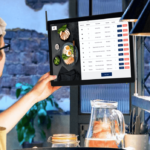Restaurants aren’t always at the forefront of implementing new technology. However, recent world events and their aftermath have led to a rapid influx of technological advancements in the industry. What started as a necessity during the pandemic has garnered much attention and will likely become a mainstay.
With the food tech market slated to be valued at nearly $342 billion USD by 2027, the demand for increased technology implementation in the industry will continue to rise. Technologies such as food delivery, ghost kitchen setups, and automated communications helped scores of restaurants remain business-worthy through the toughest times in recent history. And this seems to be just the beginning of a new era in the way food business owners operate.
Read on as we discuss the hottest tech trends in the restaurant industry and the considerations to make before opening a restaurant in 2022.
The Importance of Technology in Food Businesses
Restaurant technology allowed the food industry to survive waves of restrictions and concerns brought about by the COVID-19 pandemic. While the world continues to come out of the clutches of the novel coronavirus, restaurateurs are faced with challenges such as labor shortages and food safety concerns.
Technology allows businesses to offset labor issues and also achieve contactless delivery. That’s not all. Technology solutions also enable businesses to do better with automated inventory mapping, food preparation, and enhanced point-of-sale analytics. From a customer perspective, technology also helps better meet consumer preferences.
8 Major Restaurant Tech Trends in 2022
The last few years brought staffing shortages, supply chain issues, and delivery concerns. Restaurants thus focused on improving automation, incorporating highly-efficient software, and bringing more self-serve options to the fore. The current year is bound to see similar developments, with an increased presence of technologies to battle the challenges that continue to emerge from the aftermath of the pandemic.
Self-order Kiosks for The Modern Customer
Self-order kiosks address multiple concerns with a single, convenient solution. These tools allow tech-savvy customers to choose what each likes without being rushed. When tech-savvy customers are happy, they help build social proof for your restaurant.
Self-order kiosks also streamline customer inflow and allow staff allocation to busier parts of the restaurant by freeing up employees that would otherwise be busy taking orders. Kiosks also offer greater ordering accuracy and provide great upselling opportunities with intuitive recommendations.
POS Systems & Integration Across Platforms
Point-of-sale systems revolutionized the way restaurants work. In recent years, their integration with online ordering platforms, kitchen display systems, and self-ordering kiosks has greatly enhanced efficiency and the ease of tracking sales and expenses. The integration of cloud technology into the POS system further enhanced flexibility and interoperability.
The Return of QR Tech
While not a new invention, QR codes were back in vogue the moment the pandemic hit. QR codes now help restaurants reduce touchpoints. They thus also reduce the risk of disease transmission by offering touchless menu options. Additionally, QR codes enabled restaurants to provide easier takeout options for customers.
Automated Kitchens & Combating Staff Shortage
Artificial intelligence and machine learning are slowly helping commercial food business owners combat staff shortages. This is done by automating preparation bays in the kitchen. As a result, business owners can move staff to other areas of the kitchen where tasks aren’t as repetitive or monotonous.
Drone Delivery
From self-driving cars to drones delivering pizza, food delivery is one of the prime subsectors implementing automation to mitigate delivery challenges. Major corporations are testing drone delivery and self-drive technology. We can expect further strides in this area in the months to come.
AI & Voice Technologies
Voice technology is another area of the restaurant industry where AI is increasingly becoming prominent. Voice tech can be essential in drive-thrus and self-order kiosks. The increasing popularity of voice search and voice-activated features pushes restaurateurs to look for new ways to integrate them. Though more remains to be addressed, big firms started with AI voice bots accepting orders to streamline workflow.
Ghost Restaurants
The uptick in demand for food delivery drove advancements in food delivery applications and technologies. Ghost kitchens grew from such. Ghost kitchens are kitchens that serve customers only through their virtual platforms. Since this business model is lucrative and requires lower investment, the presence of ghost restaurants will likely continue to expand.
Chatbots & Operations
With advancements in natural language processing (NLP), chatbots have seen increased deployment on restaurant webpages. They’re easy to create and straightforward to implement. Chatbots can take orders, upsell, provide suggestions, make reservations, offer promotions, collect feedback, and even process payments.
Factors to Consider Before Starting a Restaurant in 2022
With a fast-paced and evolving climate, it’s important to remain aware of the various trends and other business-specific variables before starting your restaurant. Here are details to remember before your foray into the restaurant business in 2022:
An Overview of Restaurant Business Trends in 2022
Restaurants have been busier now that restrictions are eased. However, the landscape is quite different now. An increased focus on delivery along with offsetting labor shortages is of primary importance. Supply chain challenges affect the industry. There’s also a need to become more sustainable in the long run.
Set a Budget
Budgets are important for potential business owners, especially in the restaurant industry. Identify a number that will cover major costs like location, rent, upkeep, equipment, and estimated salaries. While this number can often be hard to hammer down, it’s important to stick to it. Remember to set aside a percentage of your budget for emergencies.
Invest in The Right Equipment & Tech
Be sure to invest in the proper restaurant equipment and technology to keep your offerings current. While quality commercial kitchen equipment helps you put out top-notch dishes for your patrons, efficient technology improves your operational metrics and helps your staff work better.
Choose Your Location Wisely
Location is one of the most important aspects to bear in mind when setting up your restaurant. Consider aspects like average income in the area, footfall, visibility, and the number of competitors in the location you prospect. When you factor these variables into the equation, you can arrive at a location best suited to your style of business.
Conclusion
Technology is now an integral part of every restaurant business. Do your research and consult professionals before you implement these advanced solutions.
Author Bio: Damon Shrauner, Senior Sales Consultant and VP on B2B Sales at CKitchen, has worked in the food service equipment sector since 1994. With his expertise in market analysis, product placement, sales, and project management, he always shares what’s best for your business.





